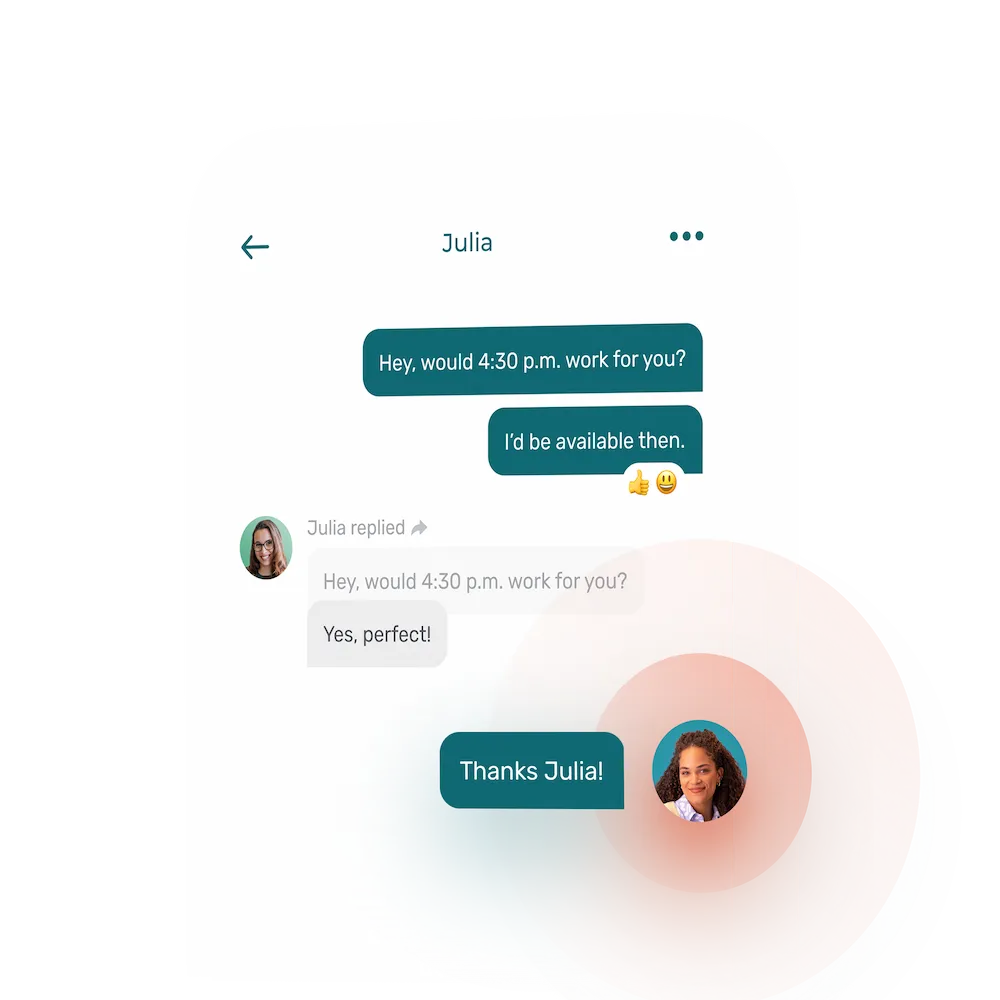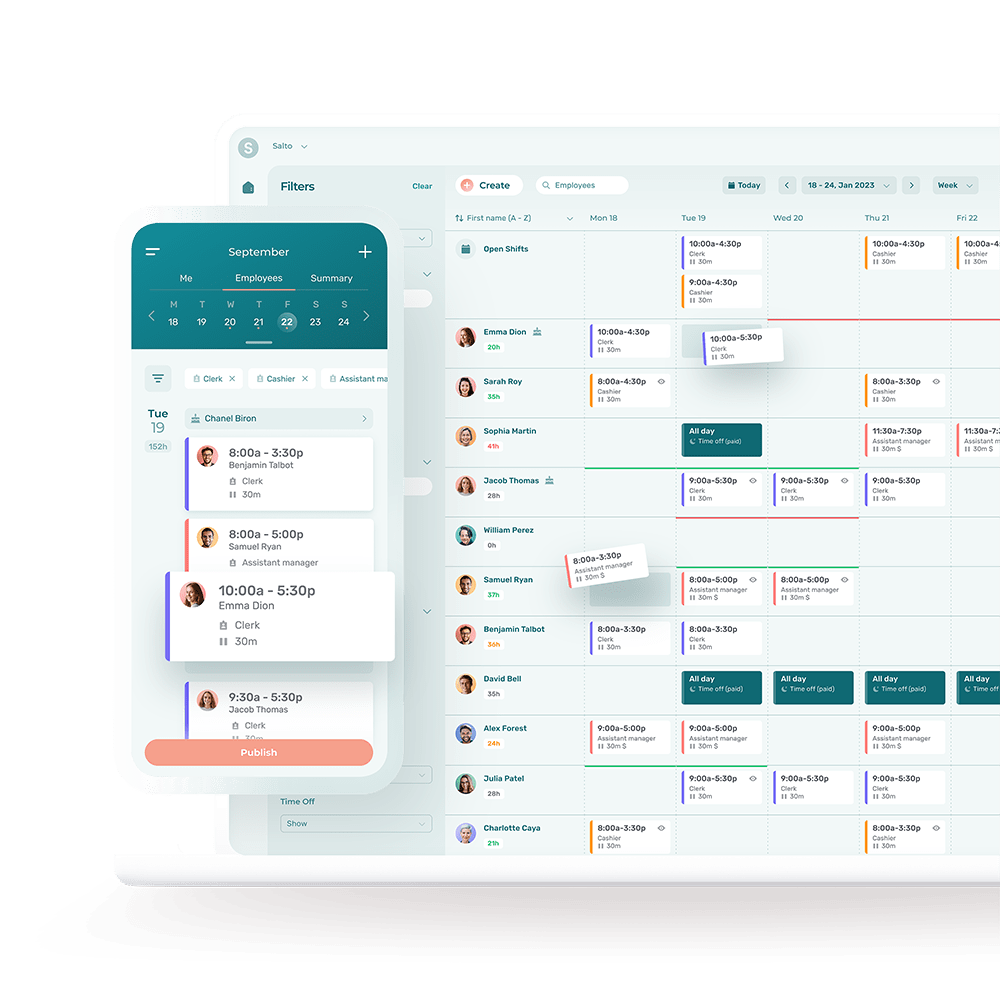HR automation helps lighten managers’ workload while also improving the employee experience—regardless of your company’s size or your industry.
2025 has only just gotten underway and already, it’s shaping up to be an economically challenging one. It is going to be important to make sure that every dollar spent is wisely invested.
Although some business owners may be reluctant to automate a portion of their operations and rely on technology to streamline their work, there is much to be gained by doing so. This is true for different areas of your business, including HR processes.
So why not automate certain tasks to maximize your time, and ultimately, your profits?
In this article you’ll learn:
- What human resources automation is
- Which HR processes can be automated
- The benefits of automation
- Elements to consider before automating your HR
Happy reading 🤓
What Is HR Automation Exactly?
HR automation refers to the use of technology, such as apps or software, to simplify processes so that they can be done with little or no need for human intervention. Automating HR makes for increased efficiency, reduced manual and repetitive tasks (which often give rise to manipulation errors), and consolidated HR practices.
⚙️ Example of HR automation: Steven is a hardware store manager responsible for hiring recruits. He uses software to streamline employee onboarding. Instead of asking employees to send him sensitive information such as their social insurance number and specimen cheque via email or Facebook Messenger, he uses secure software. This in turn minimizes the risks of information leaks during document transmission. He also uses the same software to store employee records. As a result, he does not have to handle the documents once he has received them; they are directly placed in each employee’s file.
The Automation of Each HR Process
The above example illustrates how automation can simplify the onboarding process and make it more secure. And that’s just the tip of the iceberg! Human resources automation can be used at many crucial HR stages for your company:
- Recruitment and candidate tracking
- Onboarding
- Offboarding
- Communications
- Employee records management
- HR document signature (physical or electronic signature)
- Scheduling
- Attendance and time tracking
- Task and performance management
- Training and skill development
Here are the details for each of these steps.
Recruitment and Applicant Tracking
Attracting the right candidates is essential to ensure smooth operations and outstanding customer service.
Advantages of Recruitment Automation
- Applicant tracking software makes things easier for managers and recruiters.
- Automate job posting, candidate sorting, interview planning, and the overall hiring process.
⚙️ Example of recruitment process automation: Andrea wants to find the ideal candidate to fill a manager position at her restaurant and needs to post a job offer on various websites. Her options include her company’s Facebook and Instagram pages, a specialized job posting site, and a few more general job search sites. To avoid spreading herself too thin and missing out on top candidates, she centralizes everything in her applicant tracking system, which allows her to post from a single location and filter the resumes by specific criteria.
Onboarding
Onboarding is one of the stages requiring the most paperwork and communications between a new employee and their employer. From granting access to work tools (cash register, time punch, employee manual, dress code) to sharing administrative documentation to providing preparatory training for daily tasks, there’s a lot to do.
Advantages of Onboarding Automation
- Lightens the burden on managers and the employees responsible for training new hires.
- Makes for a pleasant and uniform employee experience.
- Makes it easier to see training progress (such as training not yet completed).
⚙️ Example of onboarding process automation:
⚠️ Martin has to welcome several new interns to his hotel at two times of year: the beginning of summer and during the holidays. Each time around, the onboarding steps and necessary training are identical.
💡 Thanks to HR and onboarding automation, he can easily track each person’s progress in real time. In addition to saving a great deal of time, he is able to delegate certain steps of the training process to the rest of the team. What’s more, automation minimizes the impact of new arrivals on his workload.
Offboarding
While welcoming new talents is important, team members’ departures must be managed with the same importance and care. When an employee leaves, the key tasks include recovering any borrowed equipment, calculating the final paycheck, and conducting an exit interview. It may also be necessary to remove their alarm-system access and organize a meal to mark the departure.
Advantages of Offboarding Automation
- Helps avoid forgetting anything.
- Ensures compliance with internal protocols and legal requirements governing data protection (for example, in cases where the employee had access to sensitive customer data).
⚙️ Example of offboarding process automation:
⚠️ Samantha runs a cafe that’s very busy during the touristic season but subsequently gets much quieter. For this reason, several employees leave the organization for a few months each season, and some return the following year.
💡 To continuously improve her practices, she sends out a survey to all departing employees to learn more about various topics, namely teamwork, motivation at work, safety issues, areas for improvement, and elements that support a healthy work environment.
Communications
Poor communication can make a normally simple situation into something much harder to manage. And with all the communication channels available to interact with your team, things can easily get lost in the shuffle.
Did Anthony give you his availability by text or by Facebook Messenger? And what about Dora? When you called her, did she confirm that she would replace Vicky on Thursday night? If only you could find that note you jotted down… 😵💫
Advantages of Communication Automation
- Brings all information exchanges together on a professional communication platform, including both individual conversations and company-wide internal communications.
- Sends notifications to ensure the right people are alerted at the right time as needed.
Gone are the days when you had to do move mountains to make sure everyone got the information they needed.
⚙️ Example of communication automation:
⚠️ Adam needs to make a change to his pharmacy’s schedule for Easter holiday: he anticipates more customers, and 3 employees who were supposed to work asked him for time off at the last minute.
💡 He uses the Agendrix communication tool to send a message to all employees who are able to work the cashier and clerk positions. In under an hour, the necessary shifts are filled and the employees have confirmed their presence.
Employee Records Management
Administration is one area where most companies are hesitant to make a digital shift. This is especially true when it comes to employee records. Many companies still require a paper specimen cheque or a hard-copy emergency contact form that is then added to a binder, for instance.
Yet HR automation makes perfect sense when managing personnel files. Rather than getting overwhelmed and having outdated files lying around your back store, it helps to centralize this important information and make it available from anywhere.
Advantages of Automating Employee Records Management
- Automating and digitizing your employee records makes it easier to access information when you need it—especially in the event of a workplace accident.
- It significantly lowers the chances of people accessing your employees’ private data when it’s plainly visible on your desk.
- It gives employees access to their files, since some software offers self-service options for them to update their information and check their pay stubs and other documents.
Employee Scheduling
Drawing up work schedules can quickly become a headache when you have to factor in each employee’s availabilities and vacation requests in addition to busy times for your business, working hours, overtime, and so on.
Advantages of Scheduling Automation
- Significantly reduces the workload of managers who are responsible for scheduling.
- Centralizes employee scheduling in software that often comes with other advantages for your team, such as real-time notifications when a change occurs.
- Makes it possible to send alerts when certain criteria are not met, such as seniority, role, or availability at the time of scheduling.
- Allows for creating templates for your recurring schedules, an interesting feature of scheduling software.
⚙️ Example of scheduling automation:
⚠️ Valerie’s store has several part-time employees, most of whom are college or university students. Their availability changes every 4 months, according to their semester.
💡 Thanks to employee scheduling software, her team shares all the information with her as soon as it becomes available, allowing her to immediately take it into account when creating her monthly schedules.
Since she began centralizing her schedules, Valerie has noticed a lower turnover rate; her student employees can more easily balance work and studies when their availability is respected.
Attendance and Time Tracking
Tracking employees’ working hours is necessary for any organization, as it is a crucial step in employee compensation. Some companies use manual punch clocks to record hours, while others have a chip or barcode scanning system.
In all cases, there are many advantages to automating attendance and time tracking.
Benefits of Automating Attendance and Time Tracking
- It’s an excellent way to avoid human errors.
- Everything is recorded in an IT system and automatically accounted for.
- Payroll becomes much easier when timesheets are linked to pay.
For managers who need to closely track their employees’ overtime, automating this part of HR is essential. As a bonus, correct compensation reduces irritants for your employees.
⚙️ Example of attendance tracking automation:
⚠️ Michael is director of operations at a senior living facility. He needs to make sure that he always has the right number of staff on the floor to provide residents with quality care.
💡 His time tracking software includes an HR dashboard, which gives a real-time overview of the number of employees at work, on break, late for their shift, or who did not show up to work. He can easily get in touch with a late employee to see if they will come to work, or if they did show up but forgot to clock in when they arrived.
Task and Performance Management
Making a paper list of tasks to complete during a shift is still a widely practiced method in many frontline industries such as restaurants, retail stores, and hotels. Although this may be practical in some cases, automating it has several advantages.
Advantages of Task-Management Automation
- Better progress tracking on tasks.
- Easier transition between shifts.
- Traceability of task completion (useful for performance reviews).
- Easier identification of employees with high potential.
- Empowered decision-making for managers: if Simon never completes his tasks during the evening shift, is it because there are busier periods? Or is it because he is procrastinating and wasting time?
⚙️ Example of task-management automation:
⚠️ While reviewing end-of-shift notes in his HR management software, Matthew noticed that when Mel, Eric and Annie are together on the same shift, tasks are often done hastily. However, when Jack is present, everything is done right.
💡 So, Matthew revises the work schedule to make sure that his troublesome trio is never alone. And as a result, in the ensuing weeks, he sees a boost in productivity and even better sales.
Training and Skill Development
Automating training and skill development processes goes hand in hand with task management, as this is the stage where managers can identify certain gaps or training needs. Furthermore, automating training follow-ups allows for tracking and documenting the progress of each team member, as we well as ensuring equity.
In certain industries, training is mandatory for legal purposes, particularly when it comes to health and safety. And for some franchisees, their banner’s requirements stipulate that employees in specific roles need to undergo certain training at a given frequency.
When you automate and centralize things, you can make sure nothing is forgotten! Doing this can set you apart as an employer of choice: employees who wish to do so will be able to progress at your company and become ambassadors.
⚙️ Example of training automation:
⚠️ Samuel is a manager at a nursing home facility. The attendants there must regularly undergo training in order to stay up to date and provide the best possible care to their clientele. But since not everyone completed their training at the same time, keeping track of all this training is a headache.
💡 Having automated training processes and centralized employee records in HR software, Samuel now has deadlines with notifications for each employee, and can better plan the training needs of his team.
What Are the Advantages of Automating HR?
Ready to move forward with automating your HR? Here is a non-exhaustive list of the benefits you can reap.
1. Better Time Management
Managers and business owners can use the time they’ve saved to focus on certain aspects of their work where they have a concrete impact, such as personnel management and customer service. They can even cut down on their working hours to spend more time with their family.
HR automation optimizes otherwise repetitive and tedious tasks for which human involvement adds no real value.
2. Fewer Errors
Minimizing human intervention for certain tasks significantly reduces data manipulation errors caused by fatigue, inattention, stress, lack of time, etc.
Whether for data entry, payroll processing, assignment of recurring tasks, or schedule creation, businesses have much to gain from automating their processes.
3. Savings
Managers who are more present on the floor, do less overtime and maximize operations instead of wasting time on copy-pasting or taking handwritten notes can help an organization to make substantial savings.
HR automation contributes to better resource allocation, which, importantly, reduces labor costs.
4. Greater Compliance
Every company must at minimum comply with the requirements of labor laws in its region, which includes, among other things, retaining personnel data and following other rules. There are also other standards and regulations specific to each industry, including occupational health and safety.
Automating HR allows you to know, at any time, which practices need to be improved, and also if there are any serious flaws that need to be addressed to avoid penalties.
5. Enhanced Employee Experience
A better employee experience not only helps achieve a better staff retention rate but is also a decisive factor in attracting new talent.
Automating certain processes and offering self-service options to simplify onboarding for new employees, for example, helps your staff enjoy a more pleasant experience. The same goes for leave requests and shift swapping between employees.
6. Consistent Practices and Equity
HR automation standardizes processes and makes them consistent, contributing to more coherent practices and to a higher level of fairness for all staff members. No more favoritism or errors that penalize some of your employees!
7. Faster and Easier Recruitment
Using applicant tracking software greatly simplifies the recruitment process. It simplifies resume sorting and job interview planning, in addition to centralizing communication with applicants.
Automation makes the experience more consistent for job seekers and less time-consuming for managers.
8. Data Centralization
Data centralization is one of the biggest advantages of automating HR. All individuals who need to access the information can do so without any hassle, from managers and shift supervisors to employees and even audit managers.
9. Continuous Adaptation and Evolution
Software evolves at a rapid pace and can easily adapt to organizational needs. Whether for small or large teams, automated HR processes can be customized according to the needs and evolve with a company.
HR Automation: A Few Elements to Bear in Mind
If you are not already using tools to automate your HR, here are some elements to consider before getting started.
Initial Costs
Setting up HR systems can incur high initial costs, especially for software purchases, staff training and integrations with existing systems.
Tip: try out apps that offer a free trial before committing to a contract that binds you to the provider for several months.
Resistance to Change
Employees and managers may be reluctant to make changes to a company’s work practices. Some may think that automation will replace them while others may be fearful of using more technological tools or may prefer traditional methods— “We’ve always done things this way!” Consequently, change management is key to a successful transition to HR automation.
Lack of Skills
To succeed in HR automation, employees must acquire new skills, whether directly related to a software or simply to technology use. Identifying potential obstacles in advance or establishing the learning curve for managers can make things easier.
Complex Implementation
Not all automation tools require the same level of effort from a team to be configured and ready to use. Here too, starting by evaluating the elements to consider and the time required to become operational is critical to success. It will also be helpful to choose a solution that comes with great customer service.
Data Security Issues
The last thing a company needs is a leak of its customers’ or staff’s personal information or any other sensitive data. Wisely choosing the providers who will handle your data is therefore crucial in order to ensure peace of mind: select business partners who are on top of regulations such as Law 25 in Quebec and GDPR in Europe.
Loss of the Human Dimension
Automation can lead to a sense of disconnect and a reduction in human interaction. Make sure to observe these elements to prevent employee relationships from deteriorating or becoming problematic. For example, continue holding regular one-on-ones to find out if an employee is struggling with something. Or regularly organize team-building activities to motivate the troops.
The Burden of Working With Outdated Tools
This other point directly stems from the choice of provider and tool. It is crucial to properly evaluate the options available to you and to invest in software that will continue to evolve and regularly offer new features to support your operations. Cloud-based web and mobile solutions typically provide regular updates to fix bugs, for example.
To Automate or Not Automate Your HR: That Is the Question
As we have seen, not all is black and white when it comes to HR automation. The key is to find what best suits your needs and what will optimize your operations.
I hope this article has provided you with greater clarity on the subject and that it will help you make the best decision for your company!
What Is HR Automation?
HR automation refers to the use of software and technological applications to simplify human resources processes by reducing human manipulations. Automating HR improves efficiency, reduces manual and repetitive tasks, reduces errors, and standardizes human resources practices within an organization.
What Are the Benefits of HR Automation?
The benefits of automating HR processes include:
- Better time management
- Less human errors
- Time and financial savings
- Improved compliance with legal requirements
- Enhanced employee experience
- Standardized internal practices
- Faster and easier recruitment processes
- HR data centralization
- Better adaptability and evolution
What Are the Drawbacks of HR Automation?
HR automation can come with certain drawbacks, for example:
- Significant upfront costs
- Resistance to change within the organization
- Substantial training needs in order to address the skills gap
- The complexity of implementation
- Data security challenges
- Potential decrease in the human aspect
- More cumbersome processes
What Are Examples of HR Automation?
Examples of HR automation for frontline employees include:
- Employee scheduling, availability sharing, and shift trading via company-wide software.
- Time and attendance tracking thanks to an app connected to a punch clock system.
- Employee record centralization in a registry that can be accessed by managers and employees.
- Standardized onboarding thanks to an app.
- Leave request management from a centralized tool.
- Automatic payroll processing thanks to timesheet integration into the payroll system.















